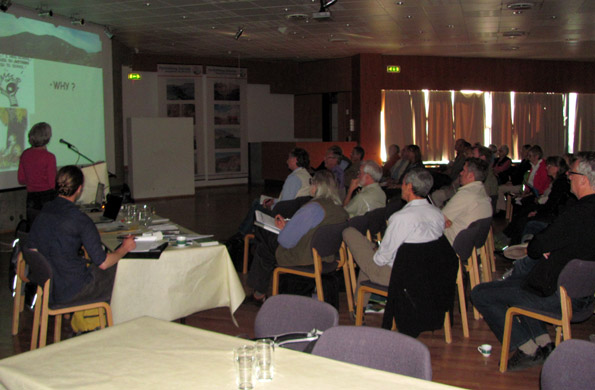In January 2013, the Isle of Man – located in the Irish Sea between Great Britain and Ireland – joined the International Appalachian Trail as the IAT hub of the British Isles.


The IoM route will follow the Raad ny Foillan, which is a 95 mile (153 km) footpath loop around the Manx coast, created in 1986 to mark the Island’s “Heritage Year” celebrations.

Also known as the Way of the Gull, the trail begins near the ferry terminal at Douglas, capital of the Isle of Man, and follows the coast wherever possible.

Douglas and the Isle of Man ferry dock
Along the way it traverses a varied terrain, from sandy beaches and seaside cliffs,

Cliffs near Calf of Man
to sheltered harbours and beachfront promenades.

Peel Beach
Using public roads when necessary, it can easily be walked in sections between towns and villages, and be completed in its entirety in 5 days. From Douglas, hikers can either turn north and make a counter-clockwise loop, or turn south and make the same trek in a clockwise direction.

Taking the south route, the trail climbs toward Douglas Head and mostly follows the coast until it reaches historic Castletown, the former capital of the Isle of Man and site of Castle Rushen and the Tynwald legislature.

Castletown
From Castletown, the trail follows the coast to the nearby Calf of Man, a 618-acre island off the southwest tip of the mainland, separated by a narrow stretch of water called the Calf Sound. From Port St. Mary to Port Erin this section of trail follows some of the most spectacular cliff scenery on the Isle of Man, including breeding grounds for seabirds and sea stacks.

View of Calf of Man
From the southwest corner of the island, the route meanders northeast along the most remote and difficult section of trail, with deep gullies and largely inaccessible beaches and caves, until it reaches the historic town of Peel, location of the island’s only Cathedral and seat of the Bishop of Sodor and Man.

Guarding the entrance to the harbour is Peel Castle, originally constructed by the Vikings who first came to the island around 800 A.D.

From Peel, the path is mostly along the trackbed of the old Manx Northern Railway as it follows the west coast of the island north until it rounds the northernmost Point of Ayre,

Point of Ayre Lighthouse, built in 1819
then heads south to Ramsay. Along the way the path affords spectacular sunsets over the Irish Sea and Isle of Man coastline.

Heading south from the Point of Ayre lighthouse, the trail follows a pebble beach along the eastern shore to Ramsay, the second largest town on the IoM (after Douglas), with a population of 7,300.

Ramsay at Dusk
The name of the town derives from the Old Norse hrams-á, meaning “wild-garlic river”.

North View of Ramsay
From Ramsay the trail ascends the nearby hills, providing great views of the town and nearby sea cliffs, before it winds its way south to Douglas, both along the coast and inland.

River Glass (Manx for Green River) located 10kms north of Douglas
Occasionally hikers get a chance to view Neolithic monuments, ruined stone farmsteads, or quaint traditional cottages.

Combined with spectacular ocean vistas and charming coastal towns, romantic seaside castles and historic lighthouses, the Isle of Man’s Raad ny Foillan is a welcome addition to the IAT family, and provides pleasant and varied walking to hikers of all abilities.
Learn more about the Raad ny Foillan.



